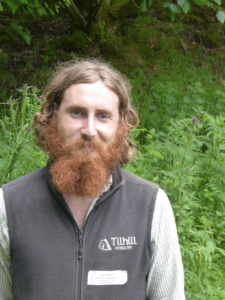
Associate member Andrew Macqueen is a Forest Manager for South West Scotland at Tilhill Forestry. Andrew was one of the hosts for ICF’s South Scotland Regional Group Meeting: Cultivation of Soils for Forestry in Tweedsmuir on the 5th of July 2017. He demonstrated a depth of knowledge about soil at the event.
“Essentially, all life depends upon the soil … There can be no life without soil and no soil without life; they have evolved together.” – Charles E. Kellogg
Despite how vital soil is to everything in the forest, it receives relatively little attention. Arguably it is our most neglected resource. Water quality is currently the most high profile environmental issue affecting forestry and for good reason. But if we consider the Hutton Institute’s figure of soil formation under typical Scottish conditions occurring at a rate of around 1cm every 400 years, then perhaps when met with pictures of dirty water careering into watercourses we should be far more shocked at the loss of our growing medium from the offending site than at the impact on the water environment. Although I suppose fast flowing burns with graceful leaping salmon are an easier sell than mud and faceless invertebrates!
Understanding Soil is Important
Soil has always been the raw material of the forester and, as we move into another era of significant woodland creation, it is as important to refresh and renew our understanding of this resource. Our predecessors were well acquainted with their soils. You only have to read a few lines of John Stirling Maxwell’s essay about afforestation at Loch Ossian or Mark Andersons ‘The Selection of Tree Species’ to get a feel for how much expertise they wielded. My own career along with many Scottish foresters of my generation has been far more focused on the restocking of existing upland plantations than on woodland creation. In truth, soils have seldom been at the forefront of the discussion, with prescriptions generally being made on the basis of maximising hectares of Sitka and then trying to fit in the compulsory other bits into what’s left over. Being introduced to the immense soil maps from the Economic Forestry Group (EFG) survey department which still existed for certain properties we manage was a great antidote to what might otherwise have turned to disenchantment. Produced using vegetation communities from aerial photography coupled with sample pits throughout the various strata, to me these maps represented exactly the type of site recognition that Anderson described in his book many years’ ago and a precursor to modern site recognition systems such as the Forestry Commission’s Ecological Site Classification (ESC). If my generation of foresters is to succeed in our own afforestation story, we must pay good attention to the pioneers of the past and take the politics of the day with a liberal pinch of salt.
How to Gain Soil Knowledge

A working knowledge of soils can be relatively easily gained but perhaps the complexity and jargon of many soil classification systems is partly responsible for putting people off as most require existing knowledge and a dictionary to decipher. With that in mind, Stephen Trudgill’s ‘Soil Types’ is a great place to start as it is fairly accessible even to those new to the subject. The Forestry Commission’s ‘The identification of Soil for Forest Management’ – very useful in its own right – has borrowed significantly from this text. Trudgill is very quick to point out that there should be a major emphasis placed on the underlying processes which have given rise to a particular soil rather than just a visual recognition of the various types. This is essential as in the field we rarely encounter the textbook definition of a soil and know that soils change, frequently intergrading into one and other. With a little knowledge and the high tech diagnostic tool that is a spade, you can build up a more useful picture than any GIS layer could ever provide.
I’ll always remember an occasion as a midyear student being sent to look at soils on clearfell sites to help inform restock prescriptions. This venture upset one colleague who was adamant I’d be wasting my time as it was all peaty gleys anyway. Of course this proved entirely untrue, as parent material, microclimate and landform can change as regularly as the soils they give rise too. It seems with many things in forestry we are far quicker to dismiss than to admit we don’t know.
Disclaimer: The views and opinions expressed in this article are those of the author and do not necessarily reflect the views of the Institute of Chartered Foresters.






